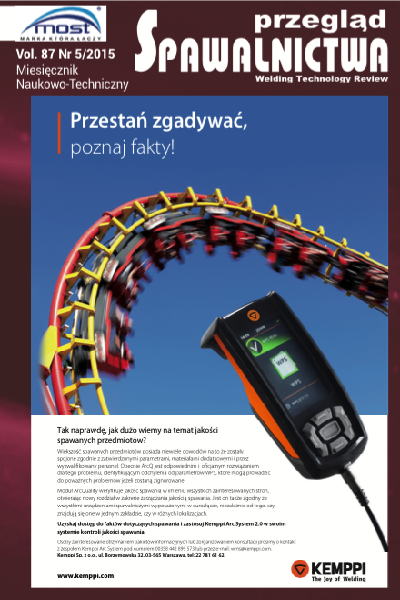Monitorowanie procesów cieplnych spawania
Main Article Content
Abstract
Ocena ciepła wprowadzonego do złącza spawanego, szczególnie na etapie opracowywania technologii spawania, czy monitorowania procesu spawania coraz częściej obejmuje bezstykowe metody pomiaru temperatury za pomocą pirometrów, termografów czy systemów termowizyjnych. Jednak pomiar promieniowania podczerwonego wyemitowanego przez nagrzane ciało związany jest z szeregiem uwarunkowań, których nieznajomość może prowadzić do niewłaściwej oceny wartości temperatury badanego obiektu. Niniejsze opracowanie przybliża niektóre aspekty, związane z monitorowaniem procesów cieplnych towarzyszących łączeniu metali z wykorzystaniem technologii spawalniczych. Przedstawiono również przykład możliwości zastosowania termowizji do rejestracji rozkładu temperatury wzdłuż drutu elektrodowego podczas spawania impulsowego w osłonie gazów ochronnych.
Monitoring of Welding Thermal Processes
Abstract
Contactless testing which allows the assessment of the temperature using pyrometer, thermograph and vision systems are used increasingly to evaluate the heat input into weld, especially during the develop- ment of welding procedure or monitoring of welding. However, the measurement of infrared radiation emitted by a heated object is dependent on many conditions ignorance of which might lead to the incorrect evaluation of the temperature value. The following work introduces some aspects of thermal processes monitoring which accompany metal joining with the use of welding technologies. The article presents the example of applications of thermovision to register of the temperature distribution at the welding electrode tip during GMAW-P.
Downloads
Article Details
Creative Commons CC BY 4.0 https://creativecommons.org/licenses/by/4.0/
Welding Technology Review (WTR) articles are published open access under a CC BY licence (Creative Commons Attribution 4.0 International licence). The CC BY licence is the most open licence available and considered the industry 'gold standard' for open access; it is also preferred by many funders. This licence allows readers to copy and redistribute the material in any medium or format, and to alter, transform, or build upon the material, including for commercial use, providing the original author is credited.
References
Kudła K., Wojsyk K.: Normowana energia liniowa a ilość ciepła wprowa- dzonego podczas spawania. Przegląd Spawalnictwa 12/2010, s. 21-25.
Wojsyk K.: Badanie metodą termograficzną energii liniowej spawania i napawania. Przegląd Spawalnictwa, 8/2007, s. 34-38.
Pietras A., Węglowska A., Kowieski Sz., Miara D.: Nowoczesne systemy monitorowania procesu zgrzewania tarciowego metodą FSW. Biuletyn Instytutu Spawalnictwa 5/2012, s. 160-167.
Havalda A.: Procesy cieplne przy spawaniu elektrycznym. WNT. Warszawa 1963.
Minkina W.: Pomiary termowizyjne przyrządy i metody. Wydawnictwo Politechniki Częstochowskiej, Częstochowa 2004.
Michalski L., Eckersdorf K., McGhee.: Temperature Measurement. John Wiley & Sons, Chichester. International Journal of Adaptive Control and Signal Processing Vol. 6, Issue 5, pp. 515-516, September 1992.
Pawlak S., Różański M., Stano S., Muzia G.: Termografia aktywna jako nowa metoda badań nieniszczących połączeń zakładkowych spawanych laserowo. Przegląd Spawalnictwa 3/2014, s. 4-10.
Halmoy E.: Wire melting rate, droplet temperature, and effective anode melting potential. paper 29, London, May, 1979, s. 49-57.
Jelmorini G., Tichelaar G.W., Van den Heuvel G.J.P.M: Droplet temperature measurements in arc welding. IIW Doc.212-411-77, 1977
Hirata Y.: Physic of welding (III) - Melting rate and temerature distribution of elektrode wire. Welding International, September 1995, nr 5, s. 348-351.
Dörhöfer F., Pomaska H.U.: Welche Anforderungen muß eine Metall- Ãktivgassschweißanlage erfüllen. Schweißen und Schneiden, 1978, nr 12, s. 491-496.
Pomaska H.U.: MAG Welding Not a Sealed Book. Linde. Industrial
Gases, Munich, 1989.
